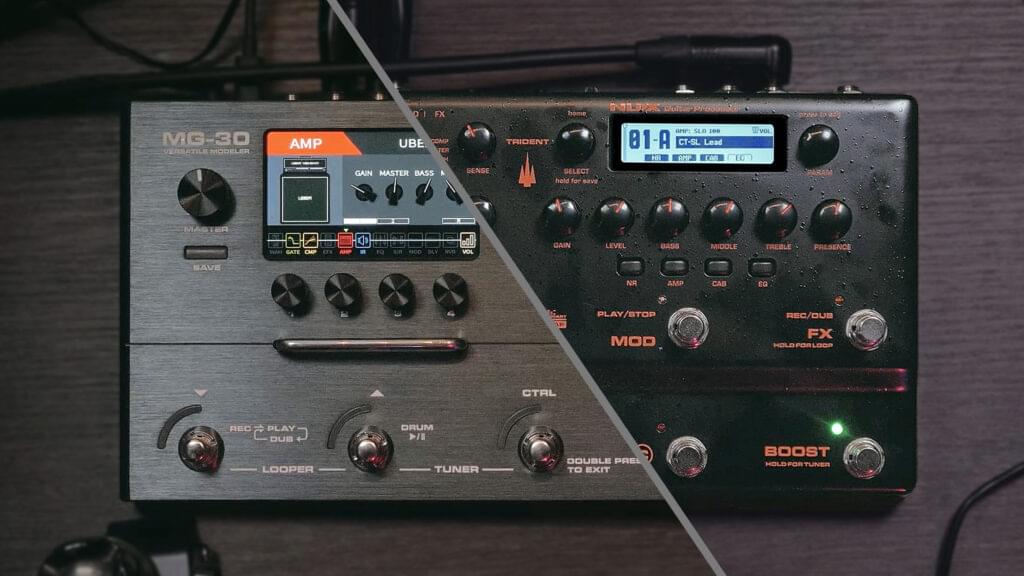
Disclaimer: Both the NUX MG-30 and Trident were provided to me by NUX, and I got to keep them for the content I create. However, whether the videos are sponsored or not, the company has no say in the things I mention in the video/post.
NUX Trident Demo: https://youtu.be/T7LOpCkdp3k
NUX MG-30 Demo: https://www.youtube.com/watch?v=-TXw0ysq3kw
Build Quality and Design
NUX Trident: One thing about the Trident is clear from the moment you see the unit: this thing is road-ready. It feels like it could survive a drop off the stage without missing a beat. Designed with live use in mind, it boasts 10 footswitches, a rugged metal chassis, and a layout that mimics a traditional pedalboard. It also offers extensive I/O, allowing you to easily integrate it with your amp or use it for reamping.
NUX MG-30: The MG-30 takes a different approach with its large display, three onboard footswitches, and an expression pedal. The minimalist design doesn’t mean it isn’t packed with features, though. In fact, it’s the most powerful modeler NUX has built to date. For those craving more footswitches for live use, the MG-30 ships with an additional two-button footswitch in the package.
Features and Flexibility
NUX Trident: The Trident is an interesting one: it’s a modeler, but it feels more like a pedalboard. The presets work in groups of three, which can feel a bit confusing at first, but once you get the hang of it, it makes a lot of sense. If you play in a band where you need to access lots of different tones and switch between different amp and pedalboard solutions quickly, the NUX Trident is one of the best units I’ve ever tried. To get a feel for how the presets work, I recommend checking out the Trident video above.
When you’re not melting faces on stage, the Trident can also act as a looper or reamping device.
NUX MG-30: The MG-30 takes a different approach with its large display, three onboard footswitches, and an expression pedal. I like the compact design, but I also see why some of you might want more footswitches. As mentioned earlier, the unit does ship with an additional two-button footswitch, but I personally would prefer a slightly bigger unit with at least four footswitches. But maybe that’s just me.
Sound Quality
You might find this take obvious/boring/uninformative, but I’m going to say it anyway: both units sound good. NUX’s amp modeling is great, and you can get excellent tones out of both units, no matter what kind of bitrates or resolutions the marketing department throws your way. And if you’re not 100% satisfied with the tones you’re getting, third-party impulse responses are your friend.
Amp and pedal selection-wise, all the classic amps and pedals are well covered, but if you’re looking for modern metal tones, these might not be the units you should get.
As I’m writing this, I realize I didn’t pay any attention to the latency of the units, meaning there isn’t anything noticeable. It’s on the same level as your Helixes and Quad Cortexes, so not an issue.
Ease of Use
Here’s where personal preferences kick in the hardest (is that how you say it?).
NUX Trident: I personally prefer the Trident’s approach because I can have unique pedalboard and amp combinations per song. For someone who has mostly used traditional pedalboards, this just makes sense. And if I want to tweak something, there are physical knobs at my feet to turn.
NUX MG-30: The MG-30, on the other hand, allows you to create more complex rigs with a preset-based approach. It’s also compact and light, so you might be able to fit it into your gig bag’s pouch. The big display makes editing tones on the fly fun and easy.
Even though there’s a bit of a learning curve to both of these units, after a few minutes, you’ll be creating your rigs in no time. To me, both units sounded equally good, and I never felt like I was running out of processing power when creating my setups.
Verdict: Which One Should You Choose?
Choosing between the NUX Trident and the MG-30 ultimately comes down to your personal preferences and how you plan to use the modeler.
- If you’re a live performer who values the tactile experience of a traditional pedalboard, the Trident is the way to go. It’s built like a tank, sounds great, and can seamlessly integrate into your current live setup, whether you’re using a real amp or a pedalboard setup.
- If you’re looking for something compact but powerful, the MG-30 is a great choice. It has more amp and pedal models than the Trident while also having a smaller footprint. The desktop app also gives you more options to route your signal, assign custom controls to footswitches, and much more. So if you need something powerful for a quick recording session, the MG-30 is your friend.
I haven’t done a direct comparison between the two units, but to me, they sound very similar (they are using the same modeling, after all), so your choice mostly comes down to the features and the number of footswitches you want to have.
If you want to get your NUX modeller and support what I do, here are some affiliate links you can use:
►►Get NUX MG-30 On Reverb: https://tidd.ly/3ALXUiq
►►Get NUX Trident At Thomann: https://thmn.to/thoprod/570179?offid=1&affid=394
►►Get NUX Trident At Reverb: https://tidd.ly/4bWfDkm
►►Get The NUX MG-30 At Thomann: https://thmn.to/thoprod/511135?offid=1&affid=394

Leave a Reply